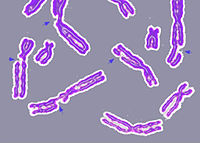
Photo from wikipedia
Simple Summary DNA repair deficiency (DRD) is common in many cancers. This deficiency contributes to pathogenesis of the disease, but it also presents an opportunity for therapeutic targeting. However, current… Click to show full abstract
Simple Summary DNA repair deficiency (DRD) is common in many cancers. This deficiency contributes to pathogenesis of the disease, but it also presents an opportunity for therapeutic targeting. However, current DRD identification assays are not available for all patients. We propose an efficient machine learning algorithm which can predict DRD from histopathological images. The utility of our method was shown by considering the detection of homologous recombination deficiency (HRD) and mismatch repair deficiency (MMRD) in breast and gastric cancer respectively. Our findings demonstrate that machine-learning approaches can be used in advanced applications to assist therapy decisions. Abstract DNA repair deficiency (DRD) is an important driver of carcinogenesis and an efficient target for anti-tumor therapies to improve patient survival. Thus, detection of DRD in tumors is paramount. Currently, determination of DRD in tumors is dependent on wet-lab assays. Here we describe an efficient machine learning algorithm which can predict DRD from histopathological images. The utility of this algorithm is demonstrated with data obtained from 1445 cancer patients. Our method performs rather well when trained on breast cancer specimens with homologous recombination deficiency (HRD), AUC (area under curve) = 0.80. Results for an independent breast cancer cohort achieved an AUC = 0.70. The utility of our method was further shown by considering the detection of mismatch repair deficiency (MMRD) in gastric cancer, yielding an AUC = 0.81. Our results demonstrate the capacity of our learning-base system as a low-cost tool for DRD detection.
Journal Title: Cancers
Year Published: 2020
Link to full text (if available)
Share on Social Media: Sign Up to like & get
recommendations!